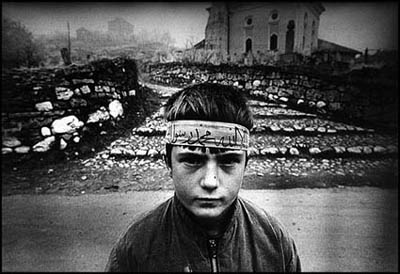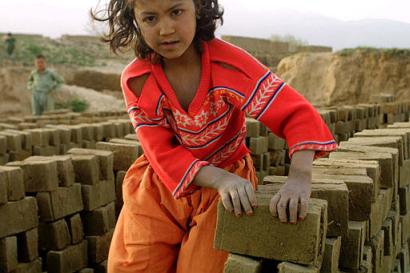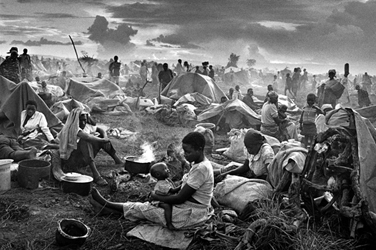| overview home page |
| peace, war & conflict |
| human rights |
| development & poverty |
| environment |

Children
Children suffer many of the same human rights abuses as adults, but may also be targeted simply because they are dependent and vulnerable. Children are tortured and mistreated by state officials; they are detained, lawfully or arbitrarily, often in appalling conditions; in some countries they are subjected to the death penalty. Countless thousands are killed or maimed in armed conflicts; many more have fled their homes to become refugees. Children forced by poverty or abuse to live on the streets are sometimes detained, attacked and even killed in the name of social cleansing. Many millions of children work at exploitative or hazardous jobs, or are the victims of child trafficking and forced prostitution. Because children are "easy targets", they are sometimes threatened, beaten or raped in order to punish family members who are not so accessible.
Amnesty International Report - Children: The Future Starts Here

Child Labor
At least 250 million children between the ages of five and 14 are working in developing countries. Approximately 120 million of these children work full time, and tens of millions of these work under exploitative and harmful conditions.
Many of the world's working children labor in occupations and industries that are dangerous or hazardous. In agriculture, large numbers of children are exposed to harmful pesticides during their formative years. Others work in occupations and industries--including mining, construction, manufacturing, and services--in which they are exposed to toxic and carcinogenic substances. Working children often perform tasks that are beyond their physical capacity, such as lifting and carrying heavy loads or handling dangerous tools and equipment. Work hazards affect children to a greater degree than adults, in some cases causing irreversible harm to their future development.
U.S. Department of Labor, By the Sweat and Toil of Children
Children and Armed Conflict
Millions of children are caught up in conflicts in which they are not merely bystanders, but targets. Some fall victim to a general onslaught against civilians; others die as part of a calculated genocide. Still other children suffer the effects of sexual violence or the multiple deprivations of armed conflict that expose them to hunger or disease. Just as shocking, thousands of young people are cynically exploited as combatants.
Graca Michel, Impact of Armed Conflict on Children, UNICEF
Women
Women and Poverty
Millions of women in developing countries live in poverty. The feminization of poverty is a growing phenomenon. Women are still the poorest of the world's poor, representing 70 percent of the 1.3 billion people who live in absolute poverty. When nearly 900 million women have incomes of less than $1 a day, the association between gender inequality and poverty remains a harrowing reality.
UNIFEM, Strengthening Women's Economic Capacity
Women work two-thirds of the world's working hours, produce half of the world's food, and yet earn only 10% of the world's income and own less than 1% of the world's property.
World Development Indicators, 1997, Womankind Worldwide

Women and Armed Conflict
During armed conflict, women and girls are continually threatened by rape, domestic violence, sexual exploitation, trafficking, sexual humiliation and mutilation. They are at heightened risk in all settings, whether at home, in flight or in camps for displaced people.
Approximately 80 per cent of people displaced by conflict or human rights violations are women and children. Displacement, internally or across borders, is disruptive and dangerous. It deprives women of the security of their community and exposes them to hunger, disease, violence and sexual assault.
UNIFEM, Women, Peace & Security
Violence Against Women
Violence against women and girls is a major health and human rights concern. Between 10% and 50% of women report they have been physically abused by an intimate partner in their lifetime. Between 12 and 25% of women have experienced attempted or completed forced sex by an intimate partner or ex-partner at some time in their lives. Forced prostitution, trafficking for sex and sex tourism appear to be growing. Studies on the trafficking of women and children estimated 500,000 women entering the European Union in 1995.
WHO Fact Sheet, Violence Against Women
Worldwide, a quarter of all women are raped during their lifetime. Depending on the country, 25 to 75 percent of women are regularly beaten at home. Over 120 million women have undergone female genital mutilation. Rape has devastated women, girls and families in recent conflicts in Rwanda, Cambodia, Liberia, Peru, Somalia, Uganda and the former Yugoslavia.
UNIFEM Press Release, 1999
Women and Decision-Making
Women hold only 12% of parliamentary seats worldwide. In the least developed countries it can be as low as 8.5%.
Equality In Practice, DFiD Report, 2000, Womankind Worldwide
Women hold only 1% of executive positions in the world's biggest international corporations.
Focus on Women, UN, 1995, Womankind Worldwide
Women and Education
There are 876 million illiterate people in the world - two thirds of them are women. This figure is not expected to decrease significantly in the next 20 years. Two thirds of school-age children in the developing world without access to education are girls.
World's Women 2000, UN, Womankind Worldwide

Refugees
Today, no continent, and barely any country, in the world is untouched by the global refugee crisis. At the beginning of 2000 an estimated 14 million people were living as refugees, uprooted from their homes and forced to cross an international border.
Huge though they are, the global refugee numbers hide an even greater displacement crisis: that of the internally displaced, those people who are forced to flee their homes, often for the very same reasons as refugees - war, civil conflict, political strife, and gross human rights abuse - but who remain within their own country, do not cross an international border, and hence are not eligible for protection under the same international system as refugees. There are an estimated 30 million internally displaced persons in the world - the number may be even higher.
Human Rights Watch
Labor Rights
Bonded Labor
Bonded labour – or debt bondage – is probably the least known form of slavery today, and yet it is the most widely used method of enslaving people. A person becomes a bonded labourer when his or her labour is demanded as a means of repayment for a loan. It is estimated that some 20 million people are held in bonded labour around the world. Bonded labourers are routinely threatened with and subjected to physical and sexual violence. They are kept under various forms of surveillance, in some cases by armed guards.
Anti-Slavery International
Sweatshops
A sweatshop is a workplace where workers are subject to extreme exploitation, including the absence of a living wage or benefits, poor working conditions, and arbitrary discipline, such as verbal and physical abuse. Sweatshops are continuously being discovered all over the world. In the U.S., these conditions exist in many low wage industries that employ immigrants, such as the garment industry.
Sweatshop Watch
Child Labor
At least 250 million children between the ages of five and 14 are working in developing countries. Approximately 120 million of these children work full time, and tens of millions of these work under exploitative and harmful conditions.